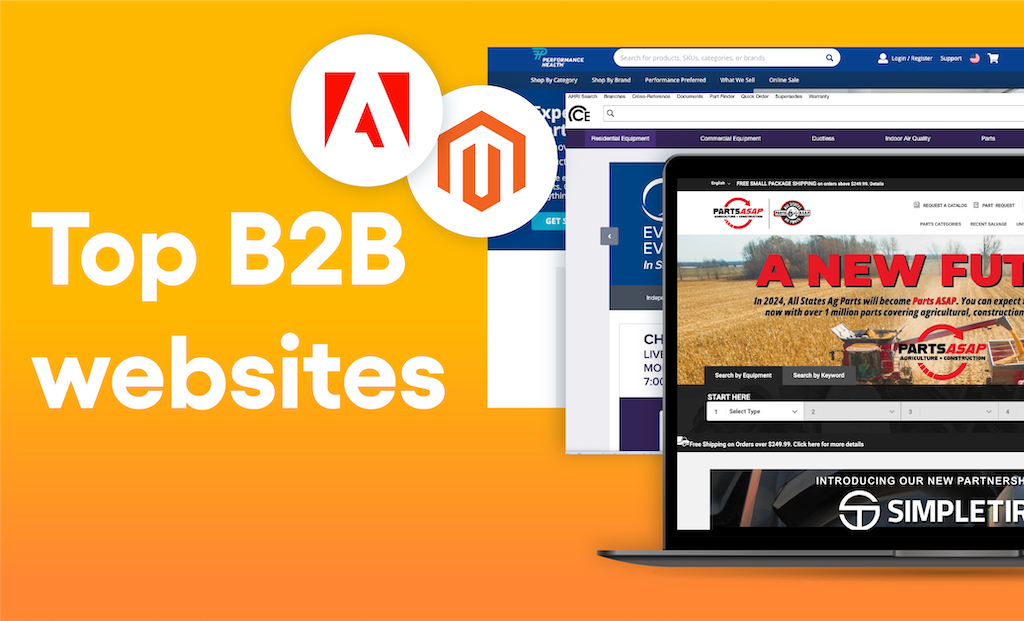A B2B distribution platform is an eCommerce platform tailored to facilitate commodity transactions between companies. With robust supply chain management capabilities, B2B distribution platforms offer efficient and intelligent transaction methods for both buyers and suppliers. These platforms also typically feature comprehensive functions such as order management, payment settlement, and after-sales service, enabling seamless cross-regional trade cooperation and expanding sales channels for companies.
Thinking of choosing Adobe Commerce (Magento) for your eCommerce project? Check out our 2024 Buyer’s Guide to Adobe Commerce for Enterprise: Costs, Features & AlternativesWe cover the ins and outs of Adobe Commerce (Magento) in order to help you make the best choice for your business, exploring key functionalities, use cases, and examples of successful implementations.2024 Buyer's Guide covering costs, alternatives, and use cases!

Magento Commerce, now officially renamed Adobe Commerce, is the market leader in eCommerce development technology. It provides a range of functions and tools to help companies quickly build efficient, scalable, and easily customizable B2B distribution platforms and other forms of eCommerce platforms.
What are the market-validated successful experiences for building B2B distribution platforms? Based on years of project practice, TMO has compiled the following six aspects for you:
1. Ensure accurate market positioning with data analysis
To develop a successful B2B distribution platform, thorough analysis of product and market data is crucial. This allows companies to understand customer needs and industry trends, and improve product positioning, marketing strategies, competitiveness, and profitability. The development team can then add necessary functions such as quick ordering, real-time inventory management, order tracking, and multi-currency support. By analyzing user behavior data, the team can further optimize these functions for better user experience.
2. Enhance professional Image with website design
To improve user experience on B2B distribution platforms, designers should consider the unique needs of B2B customers and create a simple and clear interface that enables them to quickly find and order products, as well as track their orders.
The design should reflect the enterprise’s professionalism and unique style while being consistent and easy to use. A responsive design is also important to ensure that users can access the platform on any device. Additionally, making the platform accessible to all users, including those with visual impairments or elderly users, can enhance customer satisfaction and loyalty.
3. Adapting to the Payment Needs of Enterprise Customers
The payment system of the B2B distribution platform needs to be secure, reliable, and fast, and adapt to the payment needs of enterprise customers. For small payments or standardized amounts, companies can choose to use mature third-party payment systems, such as Alipay in the Chinese market or widely popular PayPal.

Adobe Commerce offers B2B payment modules that allow companies to quickly set up their own payment process and support multiple payment methods, including credit card payment and bank transfer. The platform also provides offline payment options and purchase orders for enterprise credit limits. This caters to payment approval processes followed by some enterprise customers. Moreover, payment for orders formed after online negotiation by B2B customers is a popular payment method.
4. Automated Processing for Order Management
Effective and automated order management is an essential element of B2B distribution platforms. Adobe Commerce framework offers an order management module that enables businesses to automate processing and manage inventory efficiently.
Additionally, businesses can opt for customized development to incorporate personalized functions, such as approval processes and real-time order tracking. This feature enables businesses and users to stay informed about logistic information promptly.
5. Comprehensive Monitoring, Maintenance and Management
For any distribution platform, effective management and maintenance are key to keeping the platform running smoothly. Usually, these management and maintenance tasks include order management, inventory management, customer management, product management, etc., which can help companies achieve comprehensive monitoring of the platform.
These can be achieved by leveraging powerful tools such as Adobe Commerce’s series of modules. For example, through the customer information center, companies can track customer activities in real-time, including purchases, logins, visits, etc., and understand customer needs and purchase preferences through data analysis functions.
6. Expanding Resources by Integrating O2O Models, etc.
By integrating various business models such as O2O, companies can integrate online and offline resources to provide more comprehensive services, increase platform sales, and expand revenue channels.
*O2O (Online-to-Offline): is a consumption model where customers book or buy goods/services online and consume or receive them offline. This creates a seamless connection between online and physical stores, improving customer experience.
For example, by creating a B2B2C distribution system, companies can integrate platform self-operated sections with recruited merchants. This allows merchants to achieve independent management while the main marketplace supervises. Through the rich functions in the backend, companies can customize incentives to encourage distribution and bring more conversions through viral marketing.
Success Case: Feidekai (Fitline)Feidekai's B2B2C “New Retail” eCommerce platform offers Store Management & Procurement for its dealers, and a Marketplace for end users in the Chinese market.Feidekai
Feidekai is the main distributor of FitLine products in the Chinese market. TMO Group created a custom B2B2C “new retail” eCommerce platform for Feidekai based on Magento 2 (Adobe Commerce).
The platform uses a hybrid model that combines both selling methods: selling directly to customers and working with distributors as sales channels. Using the network of distributors allows more efficient last-mile delivery, as those distributors are usually quite close to the customers geographically. It also ensures better service levels and serves as a solid foundation for new business models, such as O2O.

Feidekai platform comprises several mobile applications and desktop apps with useful functions for users from all sides – end customers and distributors. Distributors can set up their own stores and manage them anytime, anywhere. Customers, on the other hand, can use Wechat mini program & desktop application to check products available nearby, place an order with the nearest distributor and track the status of their order.
We hope this article is helpful to you. TMO, as an Adobe-certified solution partner, provides professionalAdobe Commerce (Magento)One of the most leading solutions for eCommerce development, Adobe Commerce (Magento). Full spectrum of development services from TMO Group. Adobe Commerce (Magento) implementation services. If you have B2B distribution platform development needs or want to learn about other eCommerce development-related services, please contact us!












